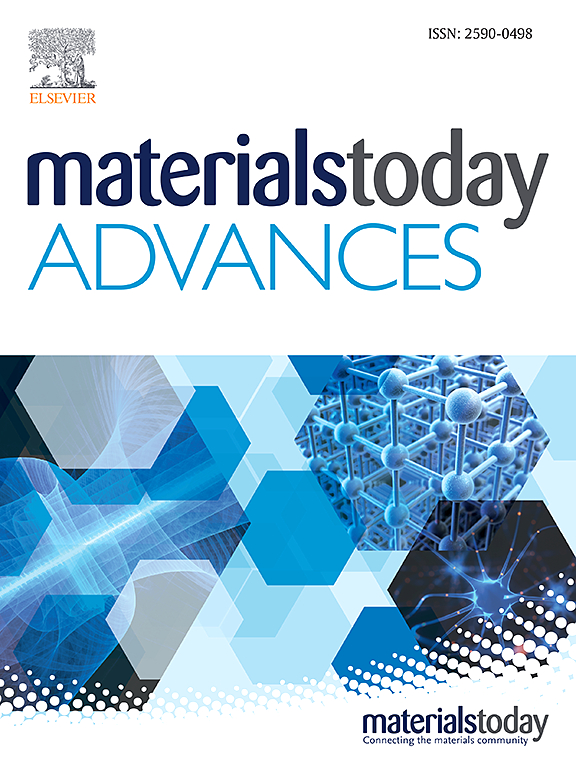Toward fast and accurate machine learning interatomic potentials for atomic layer deposition precursors
IF 8
2区 材料科学
Q1 MATERIALS SCIENCE, MULTIDISCIPLINARY
引用次数: 0
Abstract
Under thin film deposition, when used in conjunction with the semiconductor atomic layer deposition (ALD) method, the choice of precursor determines the properties and quality of the thin film. Organometallic precursors such as alkaline earth metals (Sr and Ba) and group 4 transition metals (Zr and Hf) with cyclopentadienyl and tetrakis (ethylmethylamino) ligands have recently gained attention for their stable deposition within high-temperature windows in the ALD. The design of organometallic precursors with an molecular dynamics (AIMD) simulations-based approach ensures high accuracy but comes with significant computational costs. In this study, we aim to develop a machine-learning interatomic potential (MLIP) through moment tensor potential (MTP) for fast and accurate potential development of Sr, Ba, Zr, and Hf precursors. To establish the reliable training database for MTP construction, we conducted AIMD simulations on each precursor across a range of temperature settings, resulting in a variety of atomic structures. Constructed MTPs enable efficient utilization of molecular dynamics (MD) simulations as well as calculations that achieve an accuracy that approximates density functional theory (DFT). MTP construction coupled with active learning ensures that the MTP for each precursor is reliable and that databases can be expanded. High prediction accuracy is demonstrated by a mean absolute error (MAE) of less than 0.04 eV/atom in all structures. In addition, generalization performance is confirmed for general structures (structures with the same chemical elements but different proportions) and is extended to cluster structures. The constructed MTP exhibits an MAE of less than 0.15 eV/atom, even for untrained cluster structures. These results demonstrate adequate representation and scalability as a basis for the development of MLIPs capable of atomic simulations of organometallic precursors under various thermodynamic conditions.为原子层沉积前驱体实现快速准确的机器学习原子间势能
在薄膜沉积法中,当与半导体原子层沉积法(ALD)结合使用时,前驱体的选择决定了薄膜的特性和质量。带有环戊二烯和四(乙基甲基氨基)配体的有机金属前驱体,如碱土金属(Sr 和 Ba)和第 4 族过渡金属(Zr 和 Hf),最近因其在 ALD 高温窗口内的稳定沉积而备受关注。采用基于分子动力学(AIMD)模拟的方法设计有机金属前驱体可确保高精度,但计算成本也很高。在本研究中,我们旨在通过矩张量势 (MTP) 开发一种机器学习原子间势 (MLIP),以快速准确地开发 Sr、Ba、Zr 和 Hf 前驱体的原子间势。为了建立用于构建 MTP 的可靠训练数据库,我们对每种前驱体进行了一系列温度设置下的 AIMD 模拟,从而得到了各种原子结构。通过构建 MTP,可以有效利用分子动力学(MD)模拟以及达到近似密度泛函理论(DFT)精度的计算。MTP 的构建与主动学习相结合,确保了每个前体的 MTP 都是可靠的,而且数据库可以扩展。所有结构的平均绝对误差(MAE)均小于 0.04 eV/原子,证明了预测的高准确性。此外,对一般结构(化学元素相同但比例不同的结构)的泛化性能也得到了证实,并扩展到群集结构。所构建的 MTP 的 MAE 小于 0.15 eV/原子,即使对于未经训练的群集结构也是如此。这些结果表明,MLIPs 具有充分的代表性和可扩展性,是开发能够在各种热力学条件下对有机金属前体进行原子模拟的 MLIPs 的基础。
本文章由计算机程序翻译,如有差异,请以英文原文为准。
求助全文
约1分钟内获得全文
求助全文
来源期刊

Materials Today Advances
MATERIALS SCIENCE, MULTIDISCIPLINARY-
CiteScore
14.30
自引率
2.00%
发文量
116
审稿时长
32 days
期刊介绍:
Materials Today Advances is a multi-disciplinary, open access journal that aims to connect different communities within materials science. It covers all aspects of materials science and related disciplines, including fundamental and applied research. The focus is on studies with broad impact that can cross traditional subject boundaries. The journal welcomes the submissions of articles at the forefront of materials science, advancing the field. It is part of the Materials Today family and offers authors rigorous peer review, rapid decisions, and high visibility.
 求助内容:
求助内容: 应助结果提醒方式:
应助结果提醒方式:


